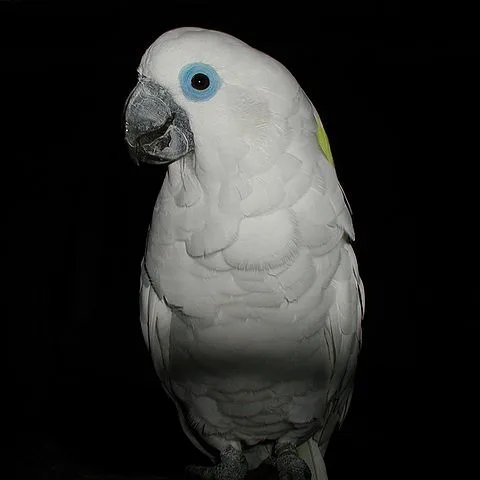
Blue-eyed Cockatoo
Subspecies
Monotypic species
Genus
Cacatua is a genus of cockatoos found from the Philippines and Wallacea east to the Solomon Islands and south to Australia. They have a primarily white plumage (in some species tinged pinkish or yellow), an expressive crest, and a black (subgenus Cacatua) or pale (subgenus Licmetis) bill. Two major subdivisions can be recognized within Cacatua. One group is characterized by the possession of heavy bills, up curving coloured crests and round wings (alba, galerita, leadbeateri, moluccensis, ophthalmica, sulphurea); within this group leadbeateri and alba have substantially smaller bills than the other species but are alike in the shapes of the crests and wings. The other subdivision has smaller bills, short uncoloured crests and more slender wings (ducorpsi, goffini, haematuropygia, pastinator, roseicapilla, tenuirostris). Large individuals of the larger species (e.g. pastinator) approach and possibly slightly overlap smaller examples of leadbeateri and alba in bill size. Today several species from this genus are considered threatened due to a combination of habitat loss and capture for the wild bird trade, with the Blue-eyed Cockatoo, Moluccan Cockatoo and Umbrella Cockatoo considered Vulnerable, the Red-vented Cockatoo considered Endangered, and the Yellow-crested Cockatoo considered Critically Endangered.
Physical charateristics
Listen to the sound of Blue-eyed Cockatoo
[audio:https://planetofbirds.com/MASTER/PSITTACIFORMES/Cacatuidae/sounds/Blue-eyed Cockatoo.mp3]
Copyright remark: Most sounds derived from xeno-canto
recorded by Keith Blomerley
| wingspan min.: | 0 | cm | wingspan max.: | 0 | cm |
| size min.: | 50 | cm | size max.: | 55 | cm |
| incubation min.: | 28 | days | incubation max.: | 30 | days |
| fledging min.: | 84 | days | fledging max.: | 90 | days |
| broods: | 1 | eggs min.: | 1 | ||
| eggs max.: | 3 |
Range
Habitat
Reproduction
Feeding habits
Video Blue-eyed Cockatoo
copyright: Keith Blomerley
Conservation
Rapid conversion of lowland forest to oil plantations over the last thirty years is likely to have caused a significant loss of breeding habitat. Although it is rare in the international trade, even limited trapping would be a cause for concern. Although the species may still appear to be relatively numerous, it is long-lived and declines in reproductive output due to deforestation may be masked.

Migration
Distribution map

